Ping Luo
Reasoning Pattern Matters: Learning to Reason without Human Rationales
Oct 14, 2025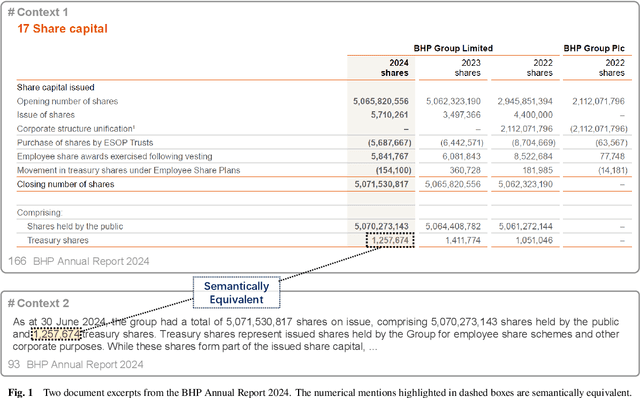
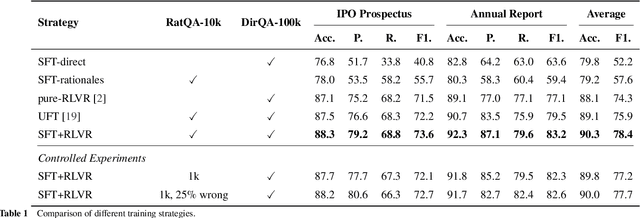
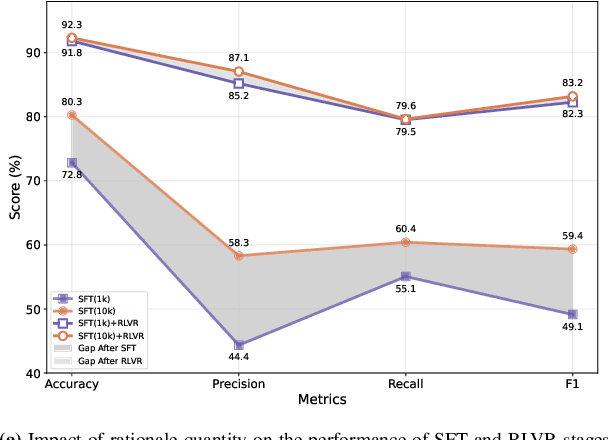
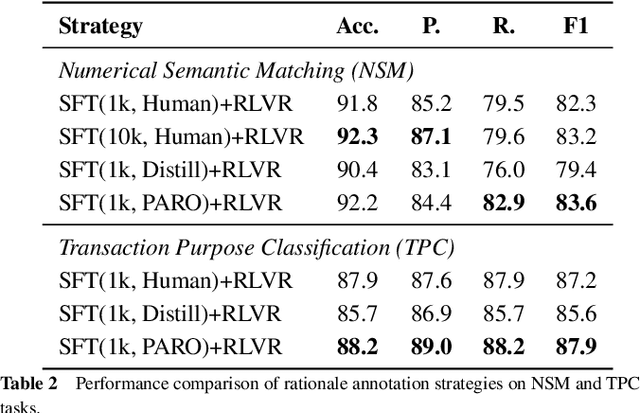
Abstract:Large Language Models (LLMs) have demonstrated remarkable reasoning capabilities under the widely adopted SFT+RLVR paradigm, which first performs Supervised Fine-Tuning (SFT) on human-annotated reasoning trajectories (rationales) to establish initial reasoning behaviors, then applies Reinforcement Learning with Verifiable Rewards (RLVR) to optimize the model using verifiable signals without golden rationales. However, annotating high-quality rationales for the SFT stage remains prohibitively expensive. This paper investigates when and how rationale annotation costs can be substantially reduced without compromising reasoning performance. We identify a broad class of problems, termed patterned reasoning tasks, where reasoning follows a fixed, procedural strategy consistent across instances. Although instances vary in content such as domain knowledge, factual information, or numeric values, the solution derives from applying a shared reasoning pattern. We argue that the success of SFT+RLVR on such tasks primarily stems from its ability to enable models to internalize these reasoning patterns. Using numerical semantic matching as a representative task, we provide both causal and behavioral evidence showing that reasoning patterns rather than the quantity or quality of rationales are the key determinant of performance. Building on these insights, we propose Pattern-Aware LLMs as Rationale AnnOtators (PARO), a simple yet effective framework that enables LLMs to generate rationales aligned with task-specific reasoning patterns without requiring human rationale annotations. Experiments show that PARO-generated rationales achieve comparable SFT+RLVR performance to human rationales that are 10 times larger. These results suggest that large-scale human rationale annotations can be replaced with LLM-based automatic annotations requiring only limited human supervision over reasoning patterns.
A Generative Foundation Model for Chest Radiography
Sep 04, 2025Abstract:The scarcity of well-annotated diverse medical images is a major hurdle for developing reliable AI models in healthcare. Substantial technical advances have been made in generative foundation models for natural images. Here we develop `ChexGen', a generative vision-language foundation model that introduces a unified framework for text-, mask-, and bounding box-guided synthesis of chest radiographs. Built upon the latent diffusion transformer architecture, ChexGen was pretrained on the largest curated chest X-ray dataset to date, consisting of 960,000 radiograph-report pairs. ChexGen achieves accurate synthesis of radiographs through expert evaluations and quantitative metrics. We demonstrate the utility of ChexGen for training data augmentation and supervised pretraining, which led to performance improvements across disease classification, detection, and segmentation tasks using a small fraction of training data. Further, our model enables the creation of diverse patient cohorts that enhance model fairness by detecting and mitigating demographic biases. Our study supports the transformative role of generative foundation models in building more accurate, data-efficient, and equitable medical AI systems.
SWIRL: A Staged Workflow for Interleaved Reinforcement Learning in Mobile GUI Control
Aug 27, 2025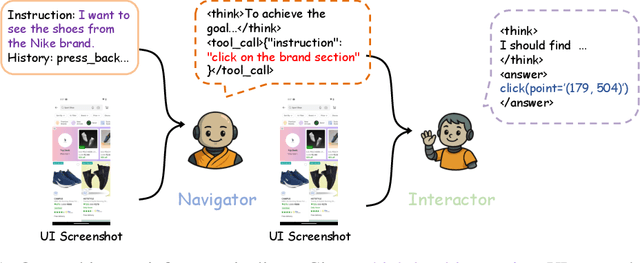
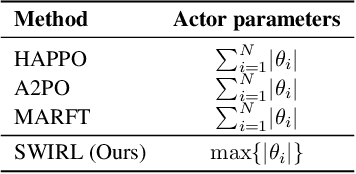
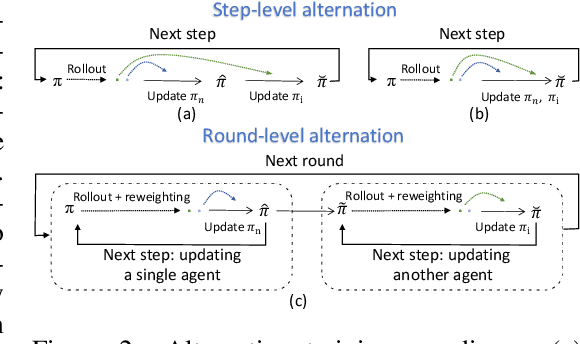

Abstract:The rapid advancement of large vision language models (LVLMs) and agent systems has heightened interest in mobile GUI agents that can reliably translate natural language into interface operations. Existing single-agent approaches, however, remain limited by structural constraints. Although multi-agent systems naturally decouple different competencies, recent progress in multi-agent reinforcement learning (MARL) has often been hindered by inefficiency and remains incompatible with current LVLM architectures. To address these challenges, we introduce SWIRL, a staged workflow for interleaved reinforcement learning designed for multi-agent systems. SWIRL reformulates MARL into a sequence of single-agent reinforcement learning tasks, updating one agent at a time while keeping the others fixed. This formulation enables stable training and promotes efficient coordination across agents. Theoretically, we provide a stepwise safety bound, a cross-round monotonic improvement theorem, and convergence guarantees on return, ensuring robust and principled optimization. In application to mobile GUI control, SWIRL instantiates a Navigator that converts language and screen context into structured plans, and an Interactor that grounds these plans into executable atomic actions. Extensive experiments demonstrate superior performance on both high-level and low-level GUI benchmarks. Beyond GUI tasks, SWIRL also demonstrates strong capability in multi-agent mathematical reasoning, underscoring its potential as a general framework for developing efficient and robust multi-agent systems.
Discrete Diffusion VLA: Bringing Discrete Diffusion to Action Decoding in Vision-Language-Action Policies
Aug 27, 2025Abstract:Vision-Language-Action (VLA) models adapt large vision-language backbones to map images and instructions to robot actions. However, prevailing VLA decoders either generate actions autoregressively in a fixed left-to-right order or attach continuous diffusion or flow matching heads outside the backbone, demanding specialized training and iterative sampling that hinder a unified, scalable architecture. We present Discrete Diffusion VLA, a single-transformer policy that models discretized action chunks with discrete diffusion and is trained with the same cross-entropy objective as the VLM backbone. The design retains diffusion's progressive refinement paradigm while remaining natively compatible with the discrete token interface of VLMs. Our method achieves an adaptive decoding order that resolves easy action elements before harder ones and uses secondary remasking to revisit uncertain predictions across refinement rounds, which improves consistency and enables robust error correction. This unified decoder preserves pretrained vision language priors, supports parallel decoding, breaks the autoregressive bottleneck, and reduces the number of function evaluations. Discrete Diffusion VLA achieves 96.3% avg. SR on LIBERO, 71.2% visual matching on SimplerEnv Fractal and 49.3% overall on SimplerEnv Bridge, improving over both autoregressive and continuous diffusion baselines. These findings indicate that discrete-diffusion action decoder supports precise action modeling and consistent training, laying groundwork for scaling VLA to larger models and datasets.
BOOD: Boundary-based Out-Of-Distribution Data Generation
Aug 01, 2025Abstract:Harnessing the power of diffusion models to synthesize auxiliary training data based on latent space features has proven effective in enhancing out-of-distribution (OOD) detection performance. However, extracting effective features outside the in-distribution (ID) boundary in latent space remains challenging due to the difficulty of identifying decision boundaries between classes. This paper proposes a novel framework called Boundary-based Out-Of-Distribution data generation (BOOD), which synthesizes high-quality OOD features and generates human-compatible outlier images using diffusion models. BOOD first learns a text-conditioned latent feature space from the ID dataset, selects ID features closest to the decision boundary, and perturbs them to cross the decision boundary to form OOD features. These synthetic OOD features are then decoded into images in pixel space by a diffusion model. Compared to previous works, BOOD provides a more training efficient strategy for synthesizing informative OOD features, facilitating clearer distinctions between ID and OOD data. Extensive experimental results on common benchmarks demonstrate that BOOD surpasses the state-of-the-art method significantly, achieving a 29.64% decrease in average FPR95 (40.31% vs. 10.67%) and a 7.27% improvement in average AUROC (90.15% vs. 97.42%) on the CIFAR-100 dataset.
Is Diversity All You Need for Scalable Robotic Manipulation?
Jul 08, 2025Abstract:Data scaling has driven remarkable success in foundation models for Natural Language Processing (NLP) and Computer Vision (CV), yet the principles of effective data scaling in robotic manipulation remain insufficiently understood. In this work, we investigate the nuanced role of data diversity in robot learning by examining three critical dimensions-task (what to do), embodiment (which robot to use), and expert (who demonstrates)-challenging the conventional intuition of "more diverse is better". Throughout extensive experiments on various robot platforms, we reveal that (1) task diversity proves more critical than per-task demonstration quantity, benefiting transfer from diverse pre-training tasks to novel downstream scenarios; (2) multi-embodiment pre-training data is optional for cross-embodiment transfer-models trained on high-quality single-embodiment data can efficiently transfer to different platforms, showing more desirable scaling property during fine-tuning than multi-embodiment pre-trained models; and (3) expert diversity, arising from individual operational preferences and stochastic variations in human demonstrations, can be confounding to policy learning, with velocity multimodality emerging as a key contributing factor. Based on this insight, we propose a distribution debiasing method to mitigate velocity ambiguity, the yielding GO-1-Pro achieves substantial performance gains of 15%, equivalent to using 2.5 times pre-training data. Collectively, these findings provide new perspectives and offer practical guidance on how to scale robotic manipulation datasets effectively.
Document-Level Tabular Numerical Cross-Checking: A Coarse-to-Fine Approach
Jun 16, 2025Abstract:Numerical consistency across tables in disclosure documents is critical for ensuring accuracy, maintaining credibility, and avoiding reputational and economic risks. Automated tabular numerical cross-checking presents two significant challenges: (C1) managing the combinatorial explosion of candidate instances at the document level and (C2) comprehending multi-faceted numerical semantics. Previous research typically depends on heuristic-based filtering or simplified context extraction, often struggling to balance performance and efficiency. Recently, large language models (LLMs) have demonstrated remarkable contextual understanding capabilities that helps address C2 at the instance level, yet they remain hampered by computational inefficiency (C1) and limited domain expertise. This paper introduces CoFiTCheck, a novel LLM-based coarse-to-fine framework that addresses these challenges through two sequential stages: embedding-based filtering and discriminative classification. The embedding-based filtering stage introduces an instructional parallel encoding method to efficiently represent all numerical mentions in a table with LLMs, as well as a decoupled InfoNCE objective to mitigate the isolated mention problem. The discriminative classification stage employs a specialized LLM for fine-grained analysis of the remaining candidate pairs. This stage is further enhanced by our crosstable numerical alignment pretraining paradigm, which leverages weak supervision from cross-table numerical equality relationships to enrich task-specific priors without requiring manual annotation. Comprehensive evaluation across three types of real-world disclosure documents demonstrates that CoFiTCheck significantly outperforms previous methods while maintaining practical efficiency.
Dynamic Mixture of Progressive Parameter-Efficient Expert Library for Lifelong Robot Learning
Jun 06, 2025Abstract:A generalist agent must continuously learn and adapt throughout its lifetime, achieving efficient forward transfer while minimizing catastrophic forgetting. Previous work within the dominant pretrain-then-finetune paradigm has explored parameter-efficient fine-tuning for single-task adaptation, effectively steering a frozen pretrained model with a small number of parameters. However, in the context of lifelong learning, these methods rely on the impractical assumption of a test-time task identifier and restrict knowledge sharing among isolated adapters. To address these limitations, we propose Dynamic Mixture of Progressive Parameter-Efficient Expert Library (DMPEL) for lifelong robot learning. DMPEL progressively learn a low-rank expert library and employs a lightweight router to dynamically combine experts into an end-to-end policy, facilitating flexible behavior during lifelong adaptation. Moreover, by leveraging the modular structure of the fine-tuned parameters, we introduce coefficient replay to guide the router in accurately retrieving frozen experts for previously encountered tasks, thereby mitigating catastrophic forgetting. This method is significantly more storage- and computationally-efficient than applying demonstration replay to the entire policy. Extensive experiments on the lifelong manipulation benchmark LIBERO demonstrate that our framework outperforms state-of-the-art lifelong learning methods in success rates across continual adaptation, while utilizing minimal trainable parameters and storage.
Aligning Latent Spaces with Flow Priors
Jun 05, 2025Abstract:This paper presents a novel framework for aligning learnable latent spaces to arbitrary target distributions by leveraging flow-based generative models as priors. Our method first pretrains a flow model on the target features to capture the underlying distribution. This fixed flow model subsequently regularizes the latent space via an alignment loss, which reformulates the flow matching objective to treat the latents as optimization targets. We formally prove that minimizing this alignment loss establishes a computationally tractable surrogate objective for maximizing a variational lower bound on the log-likelihood of latents under the target distribution. Notably, the proposed method eliminates computationally expensive likelihood evaluations and avoids ODE solving during optimization. As a proof of concept, we demonstrate in a controlled setting that the alignment loss landscape closely approximates the negative log-likelihood of the target distribution. We further validate the effectiveness of our approach through large-scale image generation experiments on ImageNet with diverse target distributions, accompanied by detailed discussions and ablation studies. With both theoretical and empirical validation, our framework paves a new way for latent space alignment.
OWMM-Agent: Open World Mobile Manipulation With Multi-modal Agentic Data Synthesis
Jun 04, 2025Abstract:The rapid progress of navigation, manipulation, and vision models has made mobile manipulators capable in many specialized tasks. However, the open-world mobile manipulation (OWMM) task remains a challenge due to the need for generalization to open-ended instructions and environments, as well as the systematic complexity to integrate high-level decision making with low-level robot control based on both global scene understanding and current agent state. To address this complexity, we propose a novel multi-modal agent architecture that maintains multi-view scene frames and agent states for decision-making and controls the robot by function calling. A second challenge is the hallucination from domain shift. To enhance the agent performance, we further introduce an agentic data synthesis pipeline for the OWMM task to adapt the VLM model to our task domain with instruction fine-tuning. We highlight our fine-tuned OWMM-VLM as the first dedicated foundation model for mobile manipulators with global scene understanding, robot state tracking, and multi-modal action generation in a unified model. Through experiments, we demonstrate that our model achieves SOTA performance compared to other foundation models including GPT-4o and strong zero-shot generalization in real world. The project page is at https://github.com/HHYHRHY/OWMM-Agent
 Add to Chrome
Add to Chrome Add to Firefox
Add to Firefox Add to Edge
Add to Edge